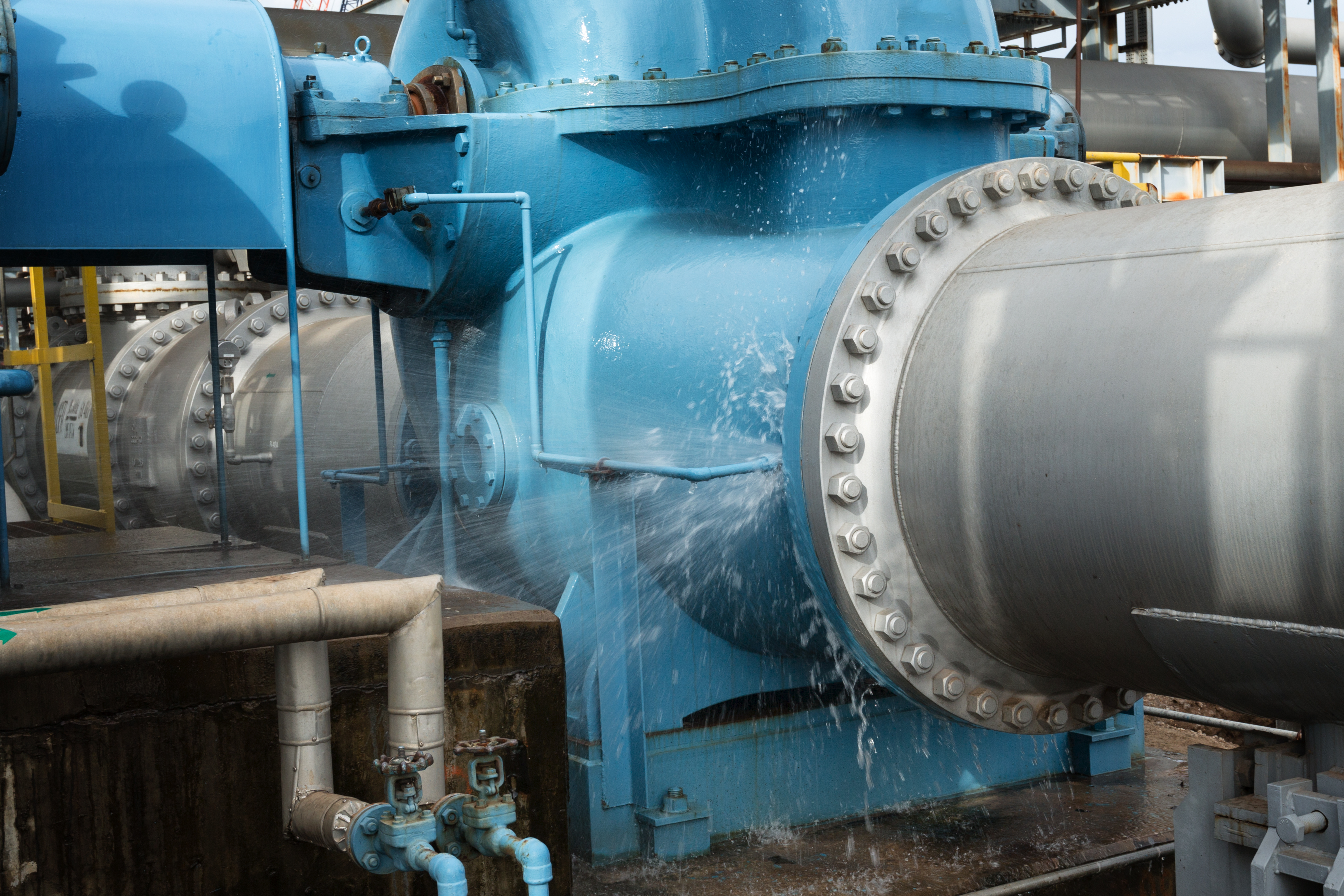Both surge and pulsation in a fluid processing system are the result of uncontrolled pressure waves caused by an abrupt change in fluid velocity. Fluid contained in an enclosed piping system has a physical volume and, therefore, its mass can be calculated. We can then determine acceleration forces needed to move that mass. Once in motion, the mass will stay in motion as long as enough force is applied to overcome friction loss plus any gravitational component. It can be said that hydraulic equilibrium is reached when the fluid is flowing in a laminar state.
Surge ("Water Hammer")
Since for all practical purposes liquids are not compressible, force or energy is not absorbed into the fluid but rather, it transfers through it. The kinetic energy of the moving fluid will exert all the force it has acquired to resist any condition that tries to cause a change in its velocity. Depending on the mass and velocity of the fluid and rate of change applied to it, highly destructive forces can be generated leading to catastrophic component or system failure.
The critical consideration when discussing surge is the change in fluid velocity. Consider a battleship moving at full speed. When the engines stop, the ship travels miles bleeding off kinetic energy through water friction before safely coming to a stop. However, if that same ship traveling at speed ran into an aircraft carrier, all of that kinetic energy would be concentrated at the point of impact with disastrous results.
When fluid velocity changes in a pumping system the result is observed as an increase or decrease in pressure. Changes in fluid velocity occur when pumps start and stop, a valve closes quickly, or there is an abrupt change in pipe diameter or direction.
 Quick-closing valves present a particularly dangerous potential for surge. A pressure wave is created when the valve closes. The initial intensity of that pressure wave is directly proportional to the flow rate before the change in velocity, and the propagation speed of the wave. The pressure wave will move through the liquid at sonic speed that can exceed 4,000 feet per second depending on the system’s attributes. The immediate increase in pressure can be calculated as: ΔP = ρ c ΔV
Quick-closing valves present a particularly dangerous potential for surge. A pressure wave is created when the valve closes. The initial intensity of that pressure wave is directly proportional to the flow rate before the change in velocity, and the propagation speed of the wave. The pressure wave will move through the liquid at sonic speed that can exceed 4,000 feet per second depending on the system’s attributes. The immediate increase in pressure can be calculated as: ΔP = ρ c ΔV
Where,
ΔP = The change in pressure from steady-state
ρ = Fluid density
c = Wave speed
ΔV = Change in velocity
Example: A valve closes abruptly causing a pressure spike upstream of the valve. Just prior to the closure, the velocity in the pipe was 10ft/sec and the operating pressure was 100 psi. Assuming the fluid was water and the system’s wave speed is 3600ft/sec, the expected pressure upstream of the valve just after the closure is 584 psi.
Note that the pressure increase is independent of normal system pressure. A system pressure of 50 psi flowing at 10ft/sec would have the same pressure spike for a given rate of change in velocity as a system pressure of 300 psi flowing at 10ft/sec but, the pressure spike in the 50 psi system would be a much higher multiple of normal system pressure.
Pulsation
Unlike surge, pulsation is the rapid uncontrolled acceleration and deceleration of fluid in motion. Think of it as uncontrolled slugs of kinetic energy moving through the pipe. The degree of pulsation is usually designated by frequency (in hertz) and pressure amplitude.
Pulsation is generally observed as vibration or rapid gauge fluctuation, and can occur and/or be influenced by the specific harmonics of various system components. Piping, valves, mechanical movement, and even system design, combine to influence measurable vibration. However, pulsation is instigated by the pump; especially, a reciprocating positive displacement pump. These pumps create their motive force by repeatedly capturing and expelling a specific volume of fluid using inlet and outlet valves, which accounts for the rapid acceleration and deceleration of fluid. Depending on the frequency and amplitude of the pulsation, the risk of system component failure is very real.
Pulsation in a pumping system will be at the frequency of the plunger or piston speed times any multiplicity factor. A reciprocating pump’s pulsation is generally described as high amplitude/low frequency, compared to the low amplitude/high frequency of a centrifugal pump’s impeller vanes. Seldom are pumping systems designed with an analysis of total system harmonics. For systems using reciprocating pumps, at the very least, consideration must be given to the effects of pulsation. In most cases, minimizing pump-generated pulsations will provide sufficient system protection. However, if the goal is to eliminate total system vibration, both system and pump harmonics must be considered. If there happens to be a harmonic match of frequencies, pressure amplification can be many times that generated by the pump alone. This is more likely to occur at higher frequencies such as those generated by a centrifugal or multi-piston pump.
For questions regarding surge and pulsation in pumping systems, Blacoh’s expert team is available to provide information and recommendations. Our expertise and advanced manufacturing capabilities, combined with an extensive lineup of products, ensure we can meet any challenge.